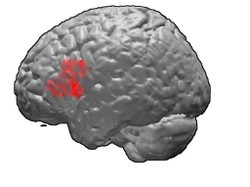Brodmann area 45
| Brodmann area 45 | |
|---|---|

Lateral surface of left cerebral hemisphere (shown in orange).
|
|
 |
|
 |
|
| Details | |
| Identifiers | |
| Latin | Area triangularis |
| NeuroLex ID | Brodmann area 45 |
| FMA | 68642 |
|
Anatomical terms of neuroanatomy
[]
|
|
Brodmann area 45 (BA45), is part of the frontal cortex in the human brain. Situated on the lateral surface, inferior to BA9 and adjacent to BA46.
This area is also known as pars triangularis (of the inferior frontal gyrus). In the human, it occupies the triangular part of inferior frontal gyrus (H) and, surrounding the anterior horizontal limb of lateral sulcus (H), a portion of the orbital part of inferior frontal gyrus (H). Bounded caudally by the anterior ascending limb of lateral sulcus (H), it borders on the insula in the depth of the lateral sulcus.
In terms of cytoarchitecture, it is bounded caudally by the opercular area 44 (BA44), rostrodorsally by the middle frontal area 46 (BA46), and ventrally by the orbital area 47 (BA47) (Brodmann, 1909).
Together with BA 44, it comprises Broca's area, a region that is active in semantic tasks, such as semantic decision tasks (determining whether a word represents an abstract or a concrete entity) and generation tasks (generating a verb associated with a noun).
The precise role of BA45 in semantic tasks remains controversial. For some researchers, its role would be to subserve semantic retrieval or semantic working memory processes. Under this view, BA44 and BA45 would together guide recovery of semantic information and evaluate the recovered information with regard to the criterion appropriate to a given context. A slightly modified account of this view is that activation of BA45 is needed only under controlled semantic retrieval, when strong stimulus-stimulus associations are absent. For other researchers, BA45's role is not restricted to semantics per se, but to all activities that require task-relevant representations from among competing representations.Lesions of the BA45 lead to the characteristic findings of expressive aphasia in individuals who are left hemispheric dominant.
...
Wikipedia
